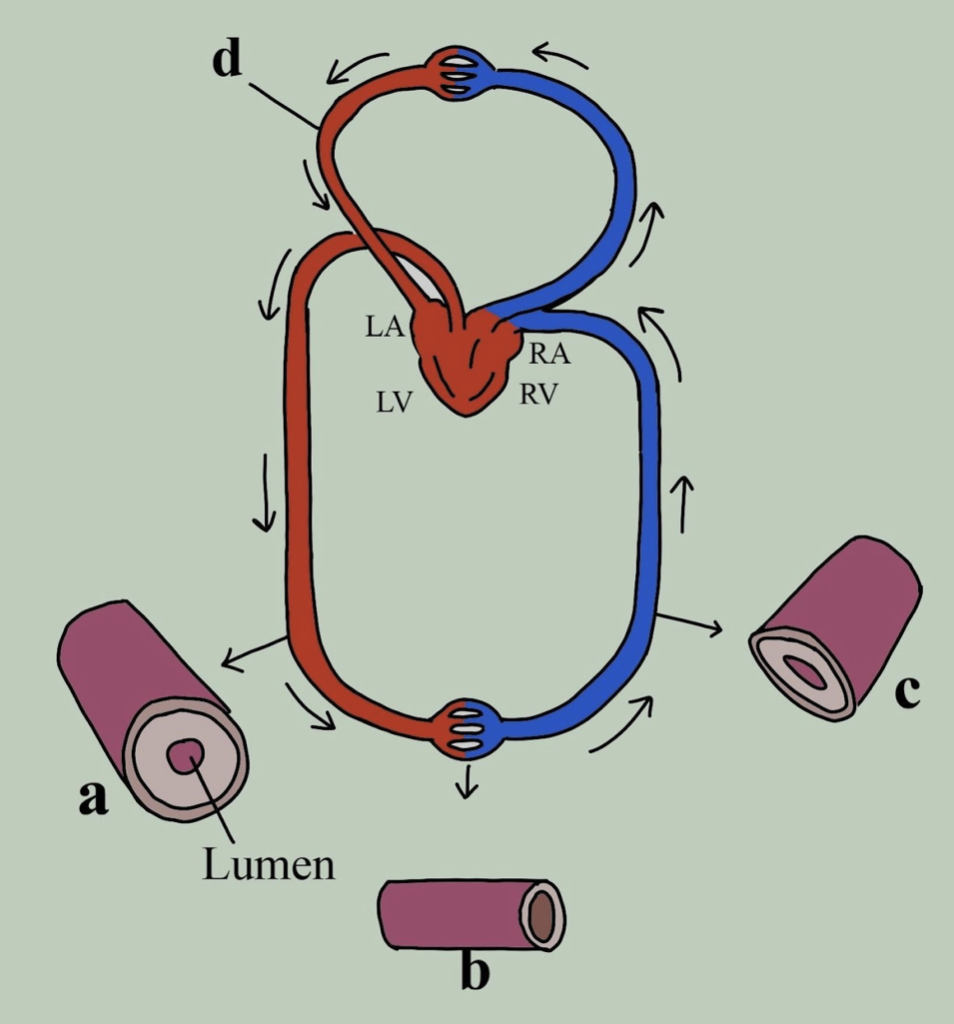
Identify the correct label with its functions from a-d.

a) c -vein, thin walled, blood flows in jerks spurts.
b) d - pulmonary vein, takes oxygenated blood to heart, pO2= 95mm Hg
c) a - artery, thick walled, blood flows evenly
d) b - capillary, thin walled, without muscle layers and wall two cell thick.

Answer
560.1k+ views
Hint: The right ventricle pumps oxygen-deficient and carbon dioxide-rich blood to the lungs through the pulmonary valve. The left atrium receives oxygen-rich blood and carbon dioxide deficient blood from the lungs and pumps it to the left ventricle. The left ventricle then pumps this blood out to the rest of the body through the aortic valve.
Complete answer:
The capillaries are very thin in structure. They are composed of two-layer cells. They have an outer layer of epithelial cells and an inner layer of endothelial cells. Their main function is to transport oxygen-rich blood to the tissue of the body and to remove the carbon dioxide from the body.
Additional information:
- Veins carry blood towards the heart. They carry deoxygenated blood from the tissues back to the heart. Pulmonary veins carry oxygen-filled blood to the heart. They transport blood in smooth flow without any jerk as the amount of blood that enters the heart is controlled by the valves present.
- Arteries carry blood away from the heart. Systemic arteries transport oxygenated blood from the left ventricle to the body. The blood in the arteries flow in the jerk spurts and is under high pressure. As arteries rely on the heart for the blood so the blood is pushed into the artery in small amounts and high pressure hence causing jerking movements.
So the answer is ‘b - capillary, thin-walled, without muscle layers and wall two-cell thick'.
Note: The blood circulatory system delivers nutrients and oxygen to the body. The arteries carry blood from the heart and transport it to the body whereas veins carry the deoxygenated blood from the body to the heart.
Complete answer:
The capillaries are very thin in structure. They are composed of two-layer cells. They have an outer layer of epithelial cells and an inner layer of endothelial cells. Their main function is to transport oxygen-rich blood to the tissue of the body and to remove the carbon dioxide from the body.
Additional information:
- Veins carry blood towards the heart. They carry deoxygenated blood from the tissues back to the heart. Pulmonary veins carry oxygen-filled blood to the heart. They transport blood in smooth flow without any jerk as the amount of blood that enters the heart is controlled by the valves present.
- Arteries carry blood away from the heart. Systemic arteries transport oxygenated blood from the left ventricle to the body. The blood in the arteries flow in the jerk spurts and is under high pressure. As arteries rely on the heart for the blood so the blood is pushed into the artery in small amounts and high pressure hence causing jerking movements.
So the answer is ‘b - capillary, thin-walled, without muscle layers and wall two-cell thick'.
Note: The blood circulatory system delivers nutrients and oxygen to the body. The arteries carry blood from the heart and transport it to the body whereas veins carry the deoxygenated blood from the body to the heart.
Recently Updated Pages
Master Class 11 Economics: Engaging Questions & Answers for Success

Master Class 11 English: Engaging Questions & Answers for Success

Master Class 11 Social Science: Engaging Questions & Answers for Success

Master Class 11 Biology: Engaging Questions & Answers for Success

Class 11 Question and Answer - Your Ultimate Solutions Guide

Master Class 11 Business Studies: Engaging Questions & Answers for Success

Trending doubts
What is meant by exothermic and endothermic reactions class 11 chemistry CBSE

10 examples of friction in our daily life

One Metric ton is equal to kg A 10000 B 1000 C 100 class 11 physics CBSE

Difference Between Prokaryotic Cells and Eukaryotic Cells

What are Quantum numbers Explain the quantum number class 11 chemistry CBSE

1 Quintal is equal to a 110 kg b 10 kg c 100kg d 1000 class 11 physics CBSE




